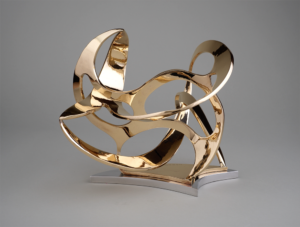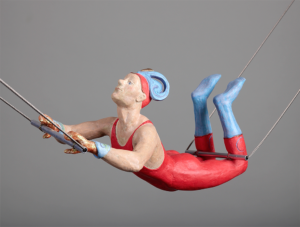Cape Cod is recognized as having the longest sustained artist colony in the United States, built on the tradition of art education starting with Charles Hawthorne in his Cape Cod School of Art in 1899. Most of the artwork produced on the Cape ends up leaving its shores one way or another, so visionary potter Harry Holl founded the Cape Cod Museum of Art in 1981 to reverse that trend. The museum retains some of the finest works in the region and holds them in public trust for exhibition and for future generations to appreciate.
The museum’s permanent collection has grown to 2,000 artworks stored and exhibited in an 18,000-square-foot facility with a museum school, a dedicated Harry Holl sculpture and clay studio, a 90-seat auditorium, seven galleries, and a sculpture garden situated on the 22-acre Cape Cod Center for the Arts campus.
Growth Can Lead to Inconsistency and Obscurity
 When the museum’s collection was a more manageable size, curatorial staff could easily access every object. But as the collection grew, their holdings became obscured, hidden between layers of inconsistent catalog management technologies and practices put in place by 12 different registrars over the years.
When the museum’s collection was a more manageable size, curatorial staff could easily access every object. But as the collection grew, their holdings became obscured, hidden between layers of inconsistent catalog management technologies and practices put in place by 12 different registrars over the years.
If objects were digitized at all, many of the digital images were hard to recognize because they were taken with amateur point-and-shoot cameras. As a result, objects were hard to locate and, in some cases, presumed missing.
“When I became responsible for managing this collection in 2018, I struggled to comprehend what was there,” said Benton Jones, Director of Art at the Cape Cod Museum of Art. “We have produced acclaimed permanent collection exhibitions, but I know now they could have been even better if the entire collection had been readily accessible and visible in our collections management database. So I contacted Digital Transitions, and at their request, I sent a spreadsheet of our collections catalog. They were instrumental in pointing me to the resources I needed and the steps required to address this challenge, starting with metadata normalization and proceeding to digitization.”
Standardizing the Metadata
Standardizing the collections’ metadata was a meticulous task. Jana Jones, the museum’s permanent registrar, spent eight months combing through the museum’s collections management system, PastPerfect, physically locating each object and then standardizing its associated metadata from the erratic entry variations that had accumulated over years. It was a tedious and necessary step toward ensuring consistency and searchability going forward.
Digitizing the Collection
For the digitization portion of the project, the Cape Cod Museum of Art called on Digital Transitions’ service division, DT Heritage. Benton Jones knew the company could offer advanced digitization solutions and technical expertise as well as decades of collections imaging experience.
 The museum’s auditorium became the primary photography studio, in part because it offered great lighting control. A Digital Transitions photographer specializing in 3D objects arrived first, and digitization kicked off in mid-June 2022.
The museum’s auditorium became the primary photography studio, in part because it offered great lighting control. A Digital Transitions photographer specializing in 3D objects arrived first, and digitization kicked off in mid-June 2022.
The team started with tabletop art, sculpture, and oversized works. Sculpture was the most challenging because objects had to be cleaned, sometimes polished, and (in extreme cases) repaired. Some sculptures required innovative setups to capture properly. One was a stone figure that needed special lighting. Another was the museum’s largest sculpture, an original plaster of Eleanor Roosevelt that barely fit into its physical space, let alone in the picture frame. Some of the longest artworks were a 20-foot-long painting and an assemblage of 20 side-by-side figures made of conch shells.
Next, Digital Transitions sent a second photographer to the museum who specialized in flat-copy capture, and then the Digital Transitions Element copy stand arrived. Handlers had to unframe and reframe the paintings and works on paper, and conservators replaced any acidic materials they uncovered in the process.
DT Heritage used a system comprising a Digital Transitions DT Element copy stand, a Digital Transitions DT Photon XL lighting system, and a Digital Transitions iXH 150 MP camera system to image works on paper as well as small paintings. Additionally, to image the 3-dimension art and installations, they used a Phase One XF 100 MP system. All components tightly integrate with Digital Transitions’ software for fast, easy preservation-grade digitization. The imaging workflow complied with the strictest FADGI and ISO 19264 guidelines.
Digitization took a lot of physical work, and several people assisted the photographers throughout the process. Museum registrar Jana Jones oversaw the daily shot list and maintained a workflow. The museum contracted skilled art handler George Perez, who doubled as a conservator when needed. There were also three volunteers trained in conservation and framing and two college interns with museum administration aspirations.

A Peek Behind the Curtain
In an unusual move for a museum, the Cape Cod Museum of Art invited the public in for a day to see how it captured its most substantial works that don’t fit on a tabletop. For example, the team reconstructed an inherently unstable, multi piece ceramic sculpture by early museum contributor Arnold Geissbuhler. When fully assembled, it measured 9 feet tall, and it didn’t come with any instructions. It was the first time in over 40 years that the sculpture had been assembled. Then it had to be lit and photographed. And it was all done in full view of the public.
“By inviting curious museum visitors to a firsthand look into the complexities we were able to overcome during this most demanding portion of our project, we were able to gain additional financial support and build greater awareness to the public benefits the digitization of our Permanent Collection would allow for.”
Order and Transparency
DT Heritage experts and museum staff began the on-site digital capture in mid-June 2022 and finished in mid-September — meaning it took just three months to prepare and digitize 2,000 works of art in many shapes, sizes, and states of repair. This remarkable feat was possible not just because of the museum’s dedicated and skilled staff and volunteers, but because of DT Heritage’s experts and Digital Transitions equipment designed for high-quality rapid capture with minimal handling.
In the process, handlers and conservators cleaned and cared for each item, restoring, and conserving any works that had previously unseen issues.
 By mid-October 2022, Digital Transitions had delivered all post-production images to the museum. This involved 2776 files in three different formats at 300 ppi 16-bit tiff cropped to include an object-level target (OLT); full-scale resolution jpeg cropped to include OLT; and a scaled resolution jpeg cropped to exclude OLT for online viewing and reproduction.
By mid-October 2022, Digital Transitions had delivered all post-production images to the museum. This involved 2776 files in three different formats at 300 ppi 16-bit tiff cropped to include an object-level target (OLT); full-scale resolution jpeg cropped to include OLT; and a scaled resolution jpeg cropped to exclude OLT for online viewing and reproduction.
High-quality images and proper cataloging have brought both efficiency and public access to the collection, which means Cape Cod Museum staff can now see every artwork digitally and clearly without having to dive into the storage racks. With high-quality images, the museum can easily publish exhibition catalogs and submit more compelling press releases, resulting in broader media coverage.
The best part is that unfettered access to the entire catalog will bring more visibility to the museum and will help staff to better preserve and conserve artworks and more thoughtfully curate the collection. And a searchable, web-based catalog with accurate images will make it possible to share with other scholars and the public without geographical or socioeconomic boundaries — aligning with the museum’s mission to excite and inspire the imaginations of all.
For more information you can contact us at [email protected].

